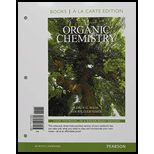
Concept explainers
(a)
Interpretation:
The proton NMR spectra to distinguish between the given pairs of compound are to be determined.
Concept introduction:
NMR spectroscopy is a technique used to determine a unique structure of the compounds. It identifies the carbon-hydrogen bonding of an organic compound. A hydrogen atom is called as a proton in the NMR spectroscopy.
(b)
Interpretation:
The proton NMR spectra to distinguish between the given pairs of compound are to be determined.
Concept introduction:
NMR spectroscopy is a technique used to determine a unique structure of the compounds. It identifies the carbon-hydrogen bonding of an organic compound. A hydrogen atom is called as a proton in the NMR spectroscopy.
(c)
Interpretation:
The proton NMR spectra to distinguish between the given pairs of compound are to be determined.
Concept introduction:
NMR spectroscopy is a technique used to determine a unique structure of the compounds. It identifies the carbon-hydrogen bonding of an organic compound. A hydrogen atom is called as a proton in the NMR spectroscopy.
(d)
Interpretation:
The proton NMR spectra to distinguish between the given pairs of compound are to be determined.
Concept introduction:
NMR spectroscopy is a technique used to determine a unique structure of the compounds. It identifies the carbon-hydrogen bonding of an organic compound. A hydrogen atom is called as a proton in the NMR spectroscopy.
Want to see the full answer?
Check out a sample textbook solution
Chapter 13 Solutions
Organic Chemistry, Books a la Carte Edition (9th Edition)
- Don't used hand raiting and don't used Ai solutionarrow_forward(9 Pts) In one of the two Rare Earth element rows of the periodic table, identify an exception tothe general ionization energy (IE) trend. For the two elements involved, answer the followingquestions. Be sure to cite sources for all physical data that you use.a. (2 pts) Identify the two elements and write their electronic configurations.b. (2 pts) Based on their configurations, propose a reason for the IE trend exception.c. (5 pts) Calculate effective nuclear charges for the last electron in each element and theAllred-Rochow electronegativity values for the two elements. Can any of these valuesexplain the IE trend exception? Explain how (not) – include a description of how IErelates to electronegativity.arrow_forwardDon't used hand raiting and don't used Ai solutionarrow_forward
- please solve this, and help me know which boxes to check. Thank you so much in advance.arrow_forwardElectronegativity is a measure of the tendency of an atom to attract a bonding pair of electrons. Describe how electronegativity is illustrated on the periodic table including trends between groups and periods and significance of atom size.arrow_forwardDefine the term “transition.” How does this definition apply to the transition metals?arrow_forward
- Describe how the properties of the different types of elements (metals, nonmetals, metalloids) differ.arrow_forwardUse a textbook or other valid source to research the physical and chemical properties of each element listed in Data Table 1 using the following as a guideline: Ductile (able to be deformed without losing toughness) and malleable (able to be hammered or pressed permanently out of shape without breaking or cracking) or not ductile or malleable Good, semi, or poor conductors of electricity and heat High or low melting and boiling points Occur or do not occur uncombined/freely in nature High, intermediate, or low reactivity Loses or gains electrons during reactions or is not reactivearrow_forwardProvide the Physical and Chemical Properties of Elements of the following elements listedarrow_forward
 Organic Chemistry: A Guided InquiryChemistryISBN:9780618974122Author:Andrei StraumanisPublisher:Cengage Learning
Organic Chemistry: A Guided InquiryChemistryISBN:9780618974122Author:Andrei StraumanisPublisher:Cengage Learning
